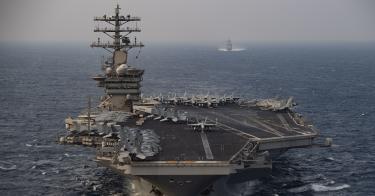Headlines recently shrieked outrage in India after an April 7 announcement from the U.S. 7th Fleet that it had conducted a freedom of navigation operation (commonly referred to as a FONOP) in the Indian Ocean targeting Indian claims. Some Indian commentators were shocked to learn that the United States, a burgeoning strategic partner, was publicly boasting about sailing warships through Indian waters to challenge India’s “excessive maritime claims”—an indignity they assumed was reserved for mutual rivals like China.
The operation generated a mini firestorm in India, providing fuel for skeptics opposed to stronger India-U.S. ties. It was paraded around as evidence of America’s unreliability, an affront to Indian sovereignty, and an act of hypocrisy from a country that has yet to ratify the United Nations Convention on the Law of the Sea (UNCLOS).
But there’s nothing new in this. The United States has conducted FONOPs directed at Indian maritime claims regularly since at least 1992. The U.S. Navy conducted at least six India-related FONOPs between then and 2003 and, with two exceptions, every year between 2007 and 2021. It’s a position consistent with the long-standing U.S. commitment to freedom of passage: one that gains credibility by not being directed at strategic rivals alone.
The FONOP program, which began in 1979, is designed to challenge maritime claims the United States finds inconsistent with international law. The operations “involve naval units transiting disputed areas to avoid setting the precedent that the international community has accepted these unlawful claims.” In the India operation this month, the United States “asserted navigational rights and freedoms approximately 130 nautical miles west of the Lakshadweep Islands, inside India’s exclusive economic zone, without requesting India’s prior consent, consistent with international law.”
In recent years, FONOPs have become a part of the mainstream discourse due to a surge in operations directed at China’s unlawful claims in the South China Sea, including around the artificial islands it began constructing there in the mid-2010s. But the program is much broader than that. In fiscal year 2018, U.S. FONOPs challenged the claims of U.S. treaty allies like Albania, Croatia, Japan, and the Philippines.
>>> The Future of the Quad Is Bright
While a FONOP directed at India wasn’t new or unusual, issuing a real-time press release about the operation was. Here, the 7th Fleet deviated from past practice of burying routine operations in the annual Freedom of Navigation Report released by the Department of Defense. Upon review, it appears the 7th Fleet has begun making public statements about all or most FONOPs this year, which may signal a shift by the Biden administration toward more consistent, real-time public messaging on these operations.
In most cases, such transparency would be welcome. However, FONOPs present a unique case where greater discretion might be advisable. At the very least, the India operation provides an opportunity to assess the merits of this shift toward greater public reporting on FONOPs and to review where India stands on the key freedom of navigation fault lines that divide the United States and China.
Despite their maturing strategic partnership, India and the United States diverge on several matters related to the UNCLOS maritime agreement. China, India, and the United States were all parties to UNCLOS negotiations. India and China ratified the treaty in 1995 and 1996, respectively. However, as is the case for China, several of India’s domestic laws and some of its practices do not comport with UNCLOS.
In contrast, the U.S. Senate has not ratified UNCLOS, but the U.S. government recognizes its provisions on maritime entitlements and the freedom of the seas as established international law, creating a paradoxical rift between the noncompliant signatories and the compliant abstainer.
One of the main points of disagreement between the United States and India relates to the latter’s claim that foreign navies seeking to operate in its 200-nautical-mile exclusive economic zone (EEZ) must first obtain the Indian government’s consent.
During the drafting of UNCLOS, several developing nations sought to get such authorities included in the treaty. Three times, their efforts failed. Instead, the treaty mainly provides coastal states with exclusive rights over economic activities like resource exploitation in their EEZ.
More than a dozen countries, China and India included, later claimed the authority to regulate military activities in their EEZs anyway, but the U.S. government and numerous other capitals and international legal experts do not recognize these claims, as they are not enshrined in UNCLOS.
The regulation of military activities in the EEZ is particularly problematic for the United States. Roughly 40 million square miles of ocean now fall within some country’s EEZ. As the Congressional Research Service notes, “if China’s position … were to gain greater international acceptance under international law, it could substantially affect U.S. naval operations not only in the [South China Sea], but around the world.”
That isn’t the only point of disagreement between India and the United States on UNCLOS, however. The U.S. FONOP this month might also have challenged India’s attempt to claim “straight baselines” around its Lakshadweep Islands. Previously, the United States has conducted FONOPs designed to challenge China’s similar attempt to draw straight baselines around the Paracel Islands. Under UNCLOS, straight baselines can only be drawn around archipelagic nation-states (like Indonesia), not island provinces or administrative regions of an existing continental state.
While there are some clear similarities in the legal positions China and India have adopted in contravention of UNCLOS, in practice they have adopted very different approaches to enforcement, diplomacy, and arbitration.
One of the key differences is that, while India has issued diplomatic protests in the past to U.S. FONOPs and military operations in its EEZ, China has operationally challenged U.S. vessels, instigating a number of dangerous encounters at sea. As China has grown more confrontational, India has grown more accommodating.
“The US regularly carries out intelligence and survey missions in India’s EEZ. These used to occasion protests from New Delhi in the past. In these fraught times, however, the government and navy prefer to remain silent on US operations in the EEZ,” the Indian analyst Manoj Joshi wrote in 2019. “There is no record of the Indian Navy having attempted to thwart US Navy ships.”
Another notable contrast lies in the diverging approaches adopted by Beijing and New Delhi toward international law and arbitration. Whereas China flatly rejected the judgment of a 2016 Permanent Court of Arbitration tribunal that invalidated several of its claims in the South China Sea, in 2014 India accepted an unfavorable ruling from the court in a maritime boundary dispute with Bangladesh, which awarded the latter the majority of the territory under dispute.
Meanwhile, in recent years, India has become an increasingly vocal advocate for freedom of navigation and upholding UNCLOS in the South China Sea. Some 90 percent of India’s international trade volume is conducted by sea, of which 55 percent traverses the South China Sea and the Strait of Malacca. India affirmed its support for the 2016 Permanent Court of Arbitration tribunal that ruled against a number of Beijing’s South China Sea claims. Indian firms have also been involved in energy exploration projects off the coast of Vietnam that fall within China’s nebulous “nine-dash line” claim, and they have refused to abandon the projects despite pressure from Beijing.
India has also grown more comfortable with the U.S. Navy operating in the Indian Ocean. In 2016, New Delhi signed the Logistics Exchange Memorandum of Agreement with Washington, making it easier for the two nations’ navies to visit each other’s port facilities, refuel each other at sea, and conduct joint exercises. In 2018, Indian Army Chief of Staff Bipin Rawat explained that India was “getting into an engagement with them [the Quad grouping of Australia, India, Japan, and the United States] to ensure there is freedom of navigation in the oceans. … We want to ensure there is a safe passage for everyone in the region.”
“The U.S., very honestly, was [in the past] very much a source of concern, even a threat. Today, the U.S. is seen much more as a partner,” explained Indian External Affairs Minister Subrahmanyam Jaishankar in 2020. “What we are seeing in the Indian Ocean is the coming together of converging interests of different players who are comfortable with each other politically, who have a shared concern for the global commons.”
Even as India seemingly grows more comfortable with an American naval presence in its backyard, it has become increasingly wary of China’s expanding naval footprint in the Indian Ocean. Alongside regular so-called anti-piracy patrols, Beijing now claims a military base in the western Indian Ocean in Djibouti and a substantial presence at Pakistan’s Gwadar Port.
As China’s presence in the Indian Ocean has expanded, so has its influence and activities in key countries across the region, including the island states of Sri Lanka and the Maldives. Indian Prime Minister Narendra Modi subsequently launched a “Neighborhood First” policy, a move widely interpreted as an attempt to check China’s growing influence in the region. In 2018, India’s chief of naval at the time acknowledged the country had begun tracking Chinese submarines when they enter the Indian Ocean.
>>> U.S. CAATSA Sanctions and India: Waivers and Geopolitical Considerations
The escalating China-India rivalry has created competing incentives for the Indian government’s approach to UNCLOS. It provides greater impetus to de-emphasize differences and improve maritime cooperation with the United States. But India is also confronting an expanding Chinese naval presence in the Indian Ocean. The Indian government thus sees an interest in maintaining and selectively applying its more restrictive patchwork of domestic laws, some of which conflict with UNCLOS. It would prefer to retain the flexibility to adopt different approaches to Indian Ocean activities by partners and antagonists.
“The U.S. must recognise that FONOPs have implications for New Delhi that go beyond the infringement of Indian jurisdiction,” the Indian naval expert Abhijit Singh wrote this week. “Such operations normalise military activism close to India’s island territories … [and the U.S. Navy’s approach] encourages other regional navies to violate India’s domestic regulations.”
While the United States would prefer to see India’s domestic laws align more closely with established international law, the Indian government is likely to resist, at least on the subject of military operations in the EEZ. Were it to get creative, New Delhi might consider more closely aligning its domestic laws with UNCLOS while enshrining exemptions for countries with which it has active territorial disputes.
In other areas, such as India’s straight baselines claims around the Lakshadweep and Andaman and Nicobar Islands, there may be more room for maneuver. Even Singh acknowledges the straight baselines claims are “a discrepancy that cannot be explained as a minor departure from the provisions of the UNCLOS.”
The Indian government and Navy have already taken a more sober approach to the recent FONOP than the media. Retired Indian naval officials recognized that the operation was legal under international law, even as they saw the publicizing of the operation as unnecessary and unwelcome.
In fact, critics in New Delhi seemed more perturbed by the statement about the FONOP than the operation itself. “If you must do it, do it quietly,” was the common refrain. It’s a recommendation the 7th Fleet might take into consideration. Just as India has resolved not to operationally challenge U.S. FONOPs or highlight their differences on UNCLOS publicly, the United States might reconsider the merits of drawing attention and controversy to an area where Indian and U.S. policies, if not their laws, are coming into greater alignment.
This piece originally appeared in Foreign Policy




